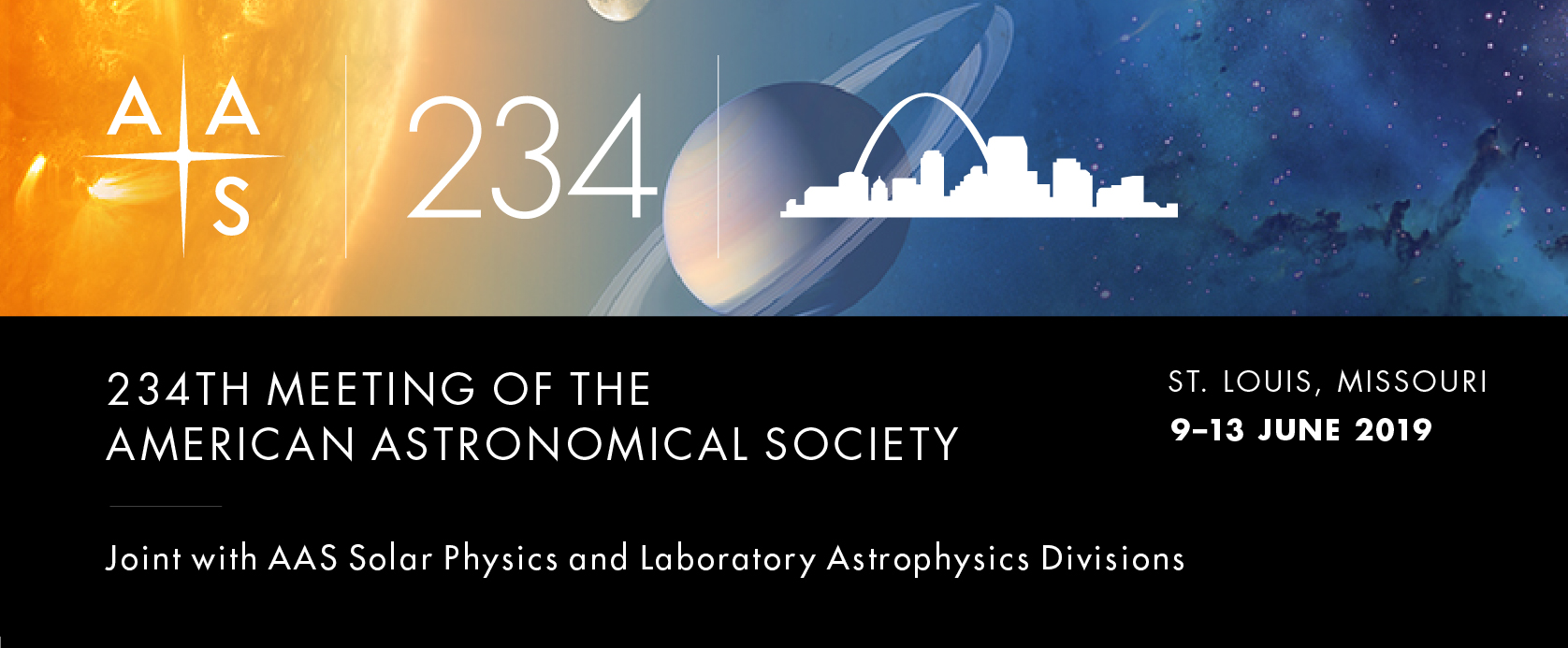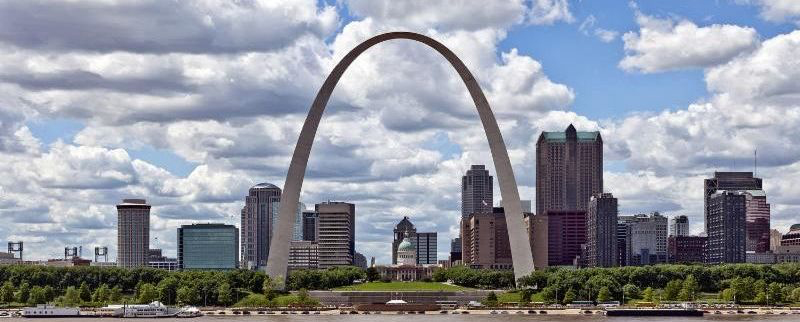AAS 234: Spotlight on Laboratory Astrophysics & Solar Physics

Richard Fienberg Running Hare Observatory

The 234th AAS meeting, convening 9-13 June at the St. Louis Union Station Hotel, Curio Collection by Hilton, 1820 Market St., St. Louis, MO 63103, is a joint meeting of the AAS and its Laboratory Astrophysics Division and Solar Physics Division. The venue is excellent; the revitalized downtown area is full of life, energy, and engaging historical and cultural activities; and you won't want to miss the city's world-famous botanical garden and zoo! Hashtag: #aas234.

St. Louis is an icon of the American Frontier — it was from here that Meriwether Lewis and William Clark set out in 1804 on their historic expedition across the American West. Two centuries later St. Louis will become an icon of the Final Frontier as hundreds of astronomers, laboratory astrophysicists, solar physicists, and other space scientists gather for what is shaping up to be one of our best summer meetings ever!
Register for AAS 234 by Tuesday, 16 April, to take advantage of the regular-registration discount; rates increase by more than 13% after that. And make your reservation at the St. Louis Union Station Hotel by 13 May to ensure that you get the special AAS group rate.
Just Added! Field Trip to Cahokia Mounds State Historic Site
Thursday, 13 June, 2:30 pm − 6:00 pm ($20)
Just 10 miles east of downtown St. Louis is Cahokia — once the largest and most sophisticated pre-Columbian city north of Mexico and the largest archaeological site in America. At its heyday from 1100 to 1200 CE, Cahokia was home to some 20,000 people and covered at least five square miles. The Mississippians who lived here were accomplished builders who erected a wide variety of structures, from practical homes for everyday living to monumental public works that have maintained their grandeur for centuries. Today more than 100 of the giant mounds built by the Cahokians remain. We will stop at the visitor center and interpretive museum and enjoy a guided tour of the site, including numerous mounds. Sign up when you register for the meeting. If you registered before we announced the field trip, you can return to your registration and add the field trip to it.
Register for AAS 234 Reserve a Hotel Room

The St. Louis skyline is instantly recognizable thanks to the 630-foot-high Gateway Arch, which you can climb via tram to get a spectacular view of the city and the Mississippi River. Built in the 1960s, the arch and the park around it recently underwent a five-year, $380 million renovation. “The district surrounding the arch was long a considered a relative eyesore thanks to a tangle of freeways, parking structures, and inexplicable detours that essentially cut the monument off from the rest of the city,” says an article in Travel & Leisure. But now the area is more accessible and attractive than ever: “The site of a multilevel concrete garage becomes an outdoor amphitheater. A grassy land bridge spans what had once been an uncrossable roaring interstate. And, most importantly, the most famous building in St. Louis is finally connected to the beating heart of downtown, with miles of new paths and uninterrupted sightlines.”
Beneath the arch you’ll find a museum where you can take a deep dive into the history of Lewis & Clark’s journey. Near Washington University in St. Louis, the Missouri History Museum has on view the original Louisiana Purchase Transfer Document that formally handed the Upper Louisiana Territory from Spain to France to the United States.
Submit Your Abstract(s)!
While the regular abstract deadline has passed, late-abstract submission is still open — for printed posters only. To share your latest research with an eager audience of scientists at all career stages, submit your abstract in one of more than 50 topical categories by 1 May at 9:00 pm ET. For details, see our Abstract Information page.
While generally you may submit only one Research or Dissertation abstract, you may also submit up to two History and/or Education abstracts. Again, see the Abstract Information page for details.
Science Program Preview
With support from the Kavli Foundation, the AAS Vice-Presidents (VPs) name a special invited lecturer to kick off each semiannual AAS meeting with a presentation on recent research of great importance. In St. Louis the Kavli Foundation Plenary Lecture, “Key Outstanding Questions in Galaxy Formation and How to Answer Them,” will be given by Alice E. Shapley (University of California, Los Angeles). And, given the proximity of the meeting to the 50th anniversary of the Apollo 11 lunar landing, the VPs have invited planetary scientist James Head (Brown University) to give a special plenary talk about Apollo’s role in advancing our scientific understanding of the Moon and how far we’ve come in the subsequent half century.
Gathering with the AAS this time are its Laboratory Astrophysics Division (LAD) and Solar Physics Division (SPD). The theme of LAD’s meeting is "Bridging Laboratory & Astrophysics," featuring two tracks of special sessions over the course of three days: one on exoplanets and the other on molecules and the Spitzer space telescope. There will also be a LAD plenary session featuring Xander Tielens (Leiden University), who will present the lecture “Dust Grains, Ices, and Surface Processes in the Interstellar Medium.” And LAD's latest prizewinners — Lucy Ziurys (Univ. of Arizona), Brett McGuire (National Radio Astronomy Observatory), and Cameron Mackie (Lawrence Berkeley National Laboratory) will all give invited presentations.
SPD will convene numerous oral and poster sessions throughout the week, and two of its 2019 prizewinners will give plenary lectures: Philip H. Scherrer (Stanford University), recipient of the George Ellery Hale Prize for his pioneering work in helioseismology and space weather, and Anthony Yeates (Durham University), recipient of the Karen Harvey Prize for his outstanding contributions to modeling the evolution of solar magnetic fields.
The St. Louis meeting offers a rich assortment of other prize and invited talks by distinguished astronomers. Yacine Ali-Haïmoud (New York University) will speak about his Helen B. Warner Prize-winning work in cosmology, including his contributions to the interpretation of Planck mission data; he’ll also lead a multisession Meeting-in-a-Meeting (MiM) that he has organized, “Cosmological Probes of Dark Matter.” Other invited lectures include Joshua Winn (Princeton University) on characterizing exoplanets, Elisabeth Mills (Brandeis University) on star formation in galaxies, Suvrath Mahadevan (Penn State University) on searching for habitable exoplanets, and Elisabeth Krause (University of Arizona) on the intersection of theoretical and observational cosmology.
There will also be a wide variety of contributed oral and poster presentations, many of which will be showcased in the “NASA Astrophysics Science SmallSat Studies” Special Session, the “WFIRST Ultra-Deep Fields” MiM, or the LAD, SPD, or MiM sessions mentioned earlier. In addition, the St. Louis program features numerous lunchtime and evening Town Hall meetings on astronomy and public policy, where you can interact with representatives from NASA, the National Science Foundation, the National Solar Observatory, the Space Telescope Science Institute, and the National Academy of Sciences, which is now gearing up for the Astro2020 decadal survey.
Join your colleagues and friends in St. Louis for AAS 234!

